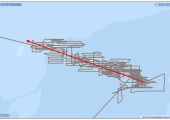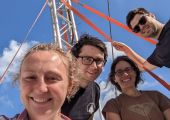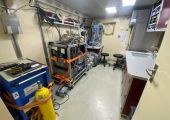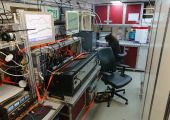
Where the Baltic Sea touches the sky - Air-Sea interaction in the Baltic Sea
07.07 - 14.07.2022 – Hunting for k!
The research groups from University of Hawaiʻi at Mānoa, USA and GEOMAR are trying to determine trace gas transfer between the ocean and atmosphere. They are using two different techniques to quantify the gas transfer velocity (k), used to compute the air-sea fluxes of a range of trace gases that are important for climate, such as carbon dioxide (CO2), nitrous oxide (N2O), methane (CH4), and dimethylsulfide (DMS).
The technique used by the Prof. Ho group from Hawaii involves injecting two inert gas tracers, sulfur hexafluoride (SF6) and the lighter isotope of helium (3He), into the surface ocean and measuring the change in their concentration over time. The technique is generally called the deliberate tracer technique, and it allows us to separate the effects of mixing/dispersion and gas exchange to determine the gas transfer velocity.
In practice, our main task on the ship is to map the tracer every day, and try to be at the center of the tracer patch to sample it with our CTD/rosette twice a day, at 6 am and 6 pm. It sounds easy, but since we are constantly going in and out of the patch in a lawnmower pattern (Figure 1) in order to map its boundaries, we are constantly losing the patch. It becomes a stressful exercise when we approach time for the sampling station. Our unofficial motto is: “it is difficult to schedule finding something you have lost”. The discrete SF6 samples are measured onboard the ship using a gas chromatograph equipped with an electron capture detector, whereas the 3He samples will be sent back to the laboratory on land and measured on a helium mass spectrometer.
The Dr. Marandino group from GEOMAR performs eddy covariance measurements to determine k. This technique requires fast and precise measurements of the vertical wind at exactly the same time as fast and precise measurements of gas concentrations, which are mathematically covaried to compute the flux. On board RV EMB295, CO2 and DMS are measured using this technique. Wind related measurements are performed on a mast built on to the front of the ship, also including inlets for CO2 and DMS (Figure 2). The analytical instrumentation for the gas measurements are located downstream of the mast (e.g., in the lab, Figure 3). This separation of measurements, as well as a moving ship, make eddy covariance data analysis a bit challenging. On top of the normal challenges, the ship’s track during the tracer hunt can make for suboptimal wind conditions for the eddy covariance method. Therefore, it is important that the ship points into the wind during the two CTD stations. For the rest of the crazy cruise track, we take as many opportunities as possible to measure under favorable wind conditions.
In order to derive k, we need to measure the air-sea gas concentration difference in addition to the fluxes. We use a gas chromatograph-mass spectrometer (GC-MS) to measure DMS concentrations in seawater. The technique requires the use of liquid nitrogen, which has become tricky during the cruise – we are now on the way to Latvia to resupply. We rely on measurements of pCO2 in seawater from the IOW (Figure 4) for deriving the CO2 k.
Over the next week, the two groups hope to garner enough overlapping data points in the tracer patch to compare their respective ks. Will they compare well? Will they have the same dependence on wind speed? Will the Baltic Sea findings match those from the open ocean? And finally, how will the elusive sea surface microlayer impact all of the above? Let’s wait and see…until then, happy hunting!
Text:
Christa Marandino (GEOMAR), Tim Steffens (GEOMAR), Tobias Spreitz (GEOMAR) and David Ho (University of Hawaiʻi at Mānoa, USA)
Coordination and editorial fine-tuning:
Bita Sabbaghzadeh (IOW) and Josefine Karnatz (GEOMAR)
| Expedition: | EMB295 |
| Mission: | CenBASE |
| Start date: | 30.06.2022 |
| End date: | 19.07.2022 |



